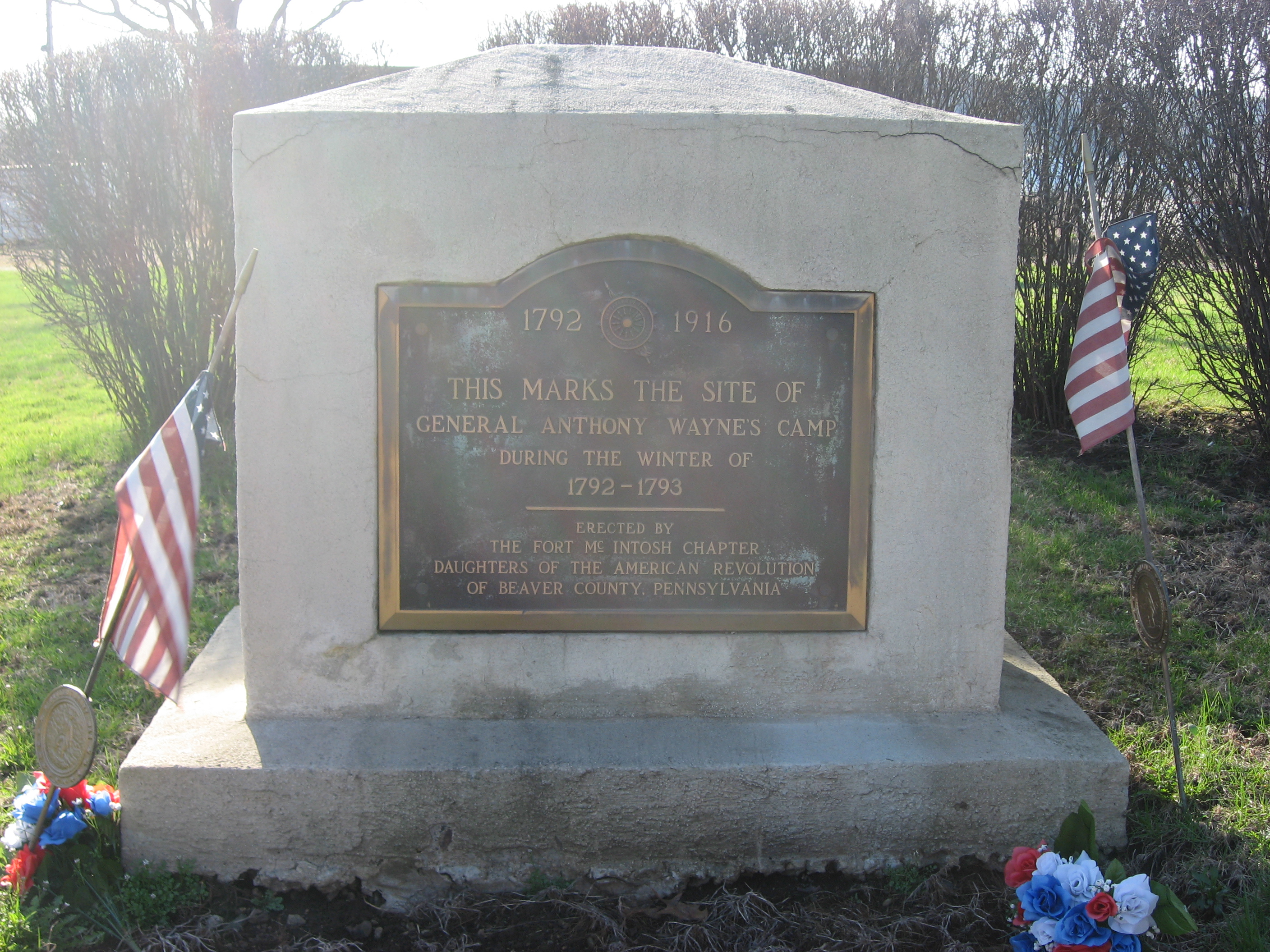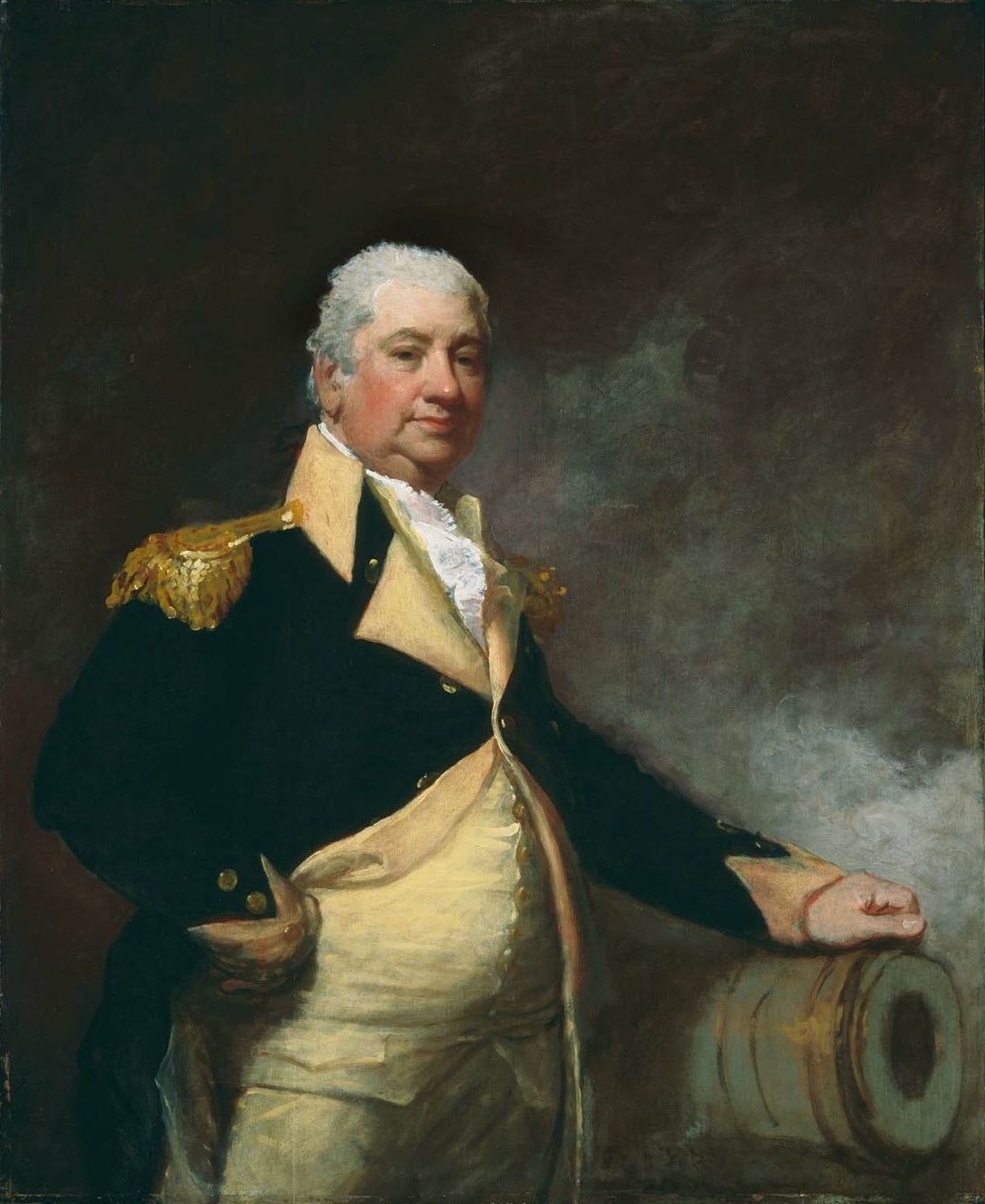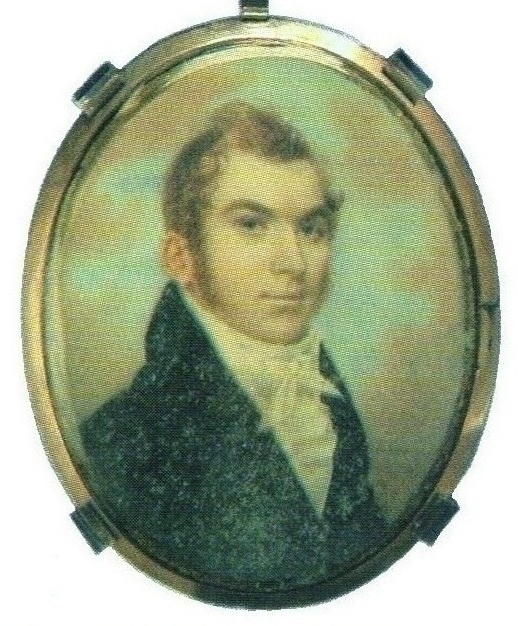|
Caleb Swan
Caleb Swan, was born in Methuen, Massachusetts July 2, 1758, but grew up in Fryeburg, Maine; he died in Washington D.C. November 11, 1809. Swan was the fifth Paymaster-General of the United States Army, serving from May 8, 1792, to June 30, 1808. He began his military career as an officer in the Continental Army. Later he served in a civilian capacity as clerk in the War Department and Indian Agent. Swan was appointed paymaster to the Legion of the United States in 1792, and Paymaster of the Army later the same year. Continental Army Caleb Swan was a namesake of his father, a graduate of Harvard College, and one of the pioneer settlers of Fryeburg, Maine who had been a lieutenant in the French and Indian War. His mother was Dorothy Frye, a niece of Joseph Frye. He was commissioned ensign in the 4th Massachusetts Regiment of the Continental Army November 26, 1779, transferred to the 8th Massachusetts Regiment January 1, 1781, and to the 3rd Massachusetts Regiment June 12, 1783. Sw ... [...More Info...] [...Related Items...] OR: [Wikipedia] [Google] [Baidu] |
Maine
Maine () is a state in the New England and Northeastern regions of the United States. It borders New Hampshire to the west, the Gulf of Maine to the southeast, and the Canadian provinces of New Brunswick and Quebec to the northeast and northwest, respectively. The largest state by total area in New England, Maine is the 12th-smallest by area, the 9th-least populous, the 13th-least densely populated, and the most rural of the 50 U.S. states. It is also the northeasternmost among the contiguous United States, the northernmost state east of the Great Lakes, the only state whose name consists of a single syllable, and the only state to border exactly one other U.S. state. Approximately half the area of Maine lies on each side of the 45th parallel north in latitude. The most populous city in Maine is Portland, while its capital is Augusta. Maine has traditionally been known for its jagged, rocky Atlantic Ocean and bayshore coastlines; smoothly contoured mountains; heavily f ... [...More Info...] [...Related Items...] OR: [Wikipedia] [Google] [Baidu] |
8th Massachusetts Regiment
The 8th Massachusetts Regiment also known as 16th Continental Regiment and Sargent's Regiment, was raised on April 23, 1775, under Colonel Paul Dudley Sargent at Cambridge, Massachusetts. The regiment would see action at the Battle of Bunker Hill, New York and New Jersey Campaign, Battle of Trenton, Battle of Princeton and the Battle of Saratoga. The regiment was furloughed June 12, 1783, at West Point, New York and disbanded on November 3, 1783. External linksBibliography of the Continental Army in Massachusetts compiled by the United States Army Center of Military History Massachusetts regiments of the Continental Army Military units and formations established in 1775 Military units and formations disestablished in 1783 {{Massachusetts-stub ... [...More Info...] [...Related Items...] OR: [Wikipedia] [Google] [Baidu] |
Treaty Of Greenville
The Treaty of Greenville, formally titled Treaty with the Wyandots, etc., was a 1795 treaty between the United States and indigenous nations of the Northwest Territory (now Midwestern United States), including the Wyandot and Delaware peoples, that redefined the boundary between indigenous peoples' lands and territory for European American community settlement. It was signed at Fort Greenville, now Greenville, Ohio, on August 3, 1795, following the Native American loss at the Battle of Fallen Timbers a year earlier. It ended the Northwest Indian War in the Ohio Country, limited Indian country to northwestern Ohio, and began the practice of annual payments following the land concessions. The parties to the treaty were a coalition of Native American tribes known as the Western Confederacy, and the United States government represented by General Anthony Wayne and local frontiersmen. The treaty became synonymous with the end of the frontier in that part of the Northwest Territo ... [...More Info...] [...Related Items...] OR: [Wikipedia] [Google] [Baidu] |
George Washington
George Washington (February 22, 1732, 1799) was an American military officer, statesman, and Founding Father who served as the first president of the United States from 1789 to 1797. Appointed by the Continental Congress as commander of the Continental Army, Washington led the Patriot forces to victory in the American Revolutionary War and served as the president of the Constitutional Convention of 1787, which created the Constitution of the United States and the American federal government. Washington has been called the " Father of his Country" for his manifold leadership in the formative days of the country. Washington's first public office was serving as the official surveyor of Culpeper County, Virginia, from 1749 to 1750. Subsequently, he received his first military training (as well as a command with the Virginia Regiment) during the French and Indian War. He was later elected to the Virginia House of Burgesses and was named a delegate to the Continental Congress ... [...More Info...] [...Related Items...] OR: [Wikipedia] [Google] [Baidu] |
Anthony Wayne
Anthony Wayne (January 1, 1745 – December 15, 1796) was an American soldier, officer, statesman, and one of the Founding Fathers of the United States. He adopted a military career at the outset of the American Revolutionary War, where his military exploits and fiery personality quickly earned him promotion to brigadier general and the nickname "Mad Anthony". He later served as the Senior Officer of the Army on the Ohio Country frontier and led the Legion of the United States. Wayne was born in Chester County, Pennsylvania, and worked as a tanner and surveyor after attending the College of Philadelphia. He was elected to the Pennsylvania General Assembly and helped raise a Pennsylvania militia unit in 1775. During the Revolutionary War, he served in the Invasion of Quebec, the Philadelphia campaign, and the Yorktown campaign. Although his reputation suffered after defeat in the Battle of Paoli, he won wide praise for his leadership in the 1779 Battle of Stony Point. After b ... [...More Info...] [...Related Items...] OR: [Wikipedia] [Google] [Baidu] |
Disbursement
A disbursement is a form of payment from a public or dedicated fund. Alternatively, it means a payment made on behalf of a client to a third party for which reimbursement is subsequently sought from the client. It is a term most commonly used by solicitors in the UK to refer to payments which they have made or will make to third parties in connection with the matter they are dealing with on behalf of the client. Section 67 of the Solicitors Act 1974 refers to disbursements as "costs payable in discharge of a liability properly incurred by he solicitoron behalf of the party to be charged with the bill". These may include court fees, counsel's fees, fees for medical or other expert reports or search fees in a property transaction. Disbursements paid by an undertaker on behalf of a bereaved family generally include cemetery or crematorium costs, costs for religious worship and any newspaper announcements. For VAT A value-added tax (VAT), known in some countries as a goods and s ... [...More Info...] [...Related Items...] OR: [Wikipedia] [Google] [Baidu] |
Legion Of The United States
The Legion of the United States was a reorganization and extension of the Continental Army from 1792 to 1796 under the command of Major General Anthony Wayne. It represented a political shift in the new United States, which had recently adopted the United States Constitution. The new Congressional and Executive branches authorized a standing army composed of professional soldiers, rather than relying on state militias. The Legion was primarily formed in reaction to multiple defeats in the Ohio country in 1790 and 1791, and to assert U.S. sovereignty over U.S. borders in the western territories and Great Lakes regions. The Legion was composed of four sub-legions, each with its own infantry, cavalry, riflemen and artillery. The Legion is best known for its victory at the Battle of Fallen Timbers in August 1794. Following the 1795 Treaty of Greenville with the Western Confederacy of Native American nations and the Jay Treaty with Great Britain, the Legion was reduced in size a ... [...More Info...] [...Related Items...] OR: [Wikipedia] [Google] [Baidu] |
Henry Schoolcraft
Henry Rowe Schoolcraft (March 28, 1793 – December 10, 1864) was an American geographer, geologist, and ethnology, ethnologist, noted for his early studies of Native Americans in the United States, Native American cultures, as well as for his 1832 expedition to the source of the Mississippi River. He is also noted for his major six-volume study of Native Americans commissioned by Congress and published in the 1850s. He served as United States Indian agent in Michigan for a period beginning in 1822. During this period, he named several newly organized counties, often creating neologisms that he claimed were derived from indigenous languages. There he married Jane Johnston Schoolcraft, Jane Johnston, daughter of a prominent Scotch-Irish American, Scotch-Irish fur trader and an Ojibwe mother, who was the high-ranking daughter of Waubojeeg, a war chief. Johnston lived with her family in Sault Ste. Marie, Michigan. Johnston was bilingual and educated, having grown up in a literate ... [...More Info...] [...Related Items...] OR: [Wikipedia] [Google] [Baidu] |
Treaty Of New York (1790)
The Treaty of New York was a treaty signed in 1790 between leaders of the Muscogee and U.S. Secretary of War Henry Knox, who served in the presidential administration of George Washington. A failed 1789 attempt at a treaty between the United States and the Muscogee at Rock Landing, Georgia in 1789, was abruptly ended by Muscogee leader Alexander McGillivray, who described his grievances in a letter to the U.S. commissioners. Washington sent a special emissary, Marinus Willett, to McGillvray and persuaded him to come to New York City, which was the U.S. capital, to conduct a treaty with Washington and Knox directly. In the summer of 1790, twenty-seven Muscogee leaders, led by McGillivray, traveled to New York and signed a treaty on behalf of the "Upper, Middle, and Lower Creek and Seminole composing the Creek nation of Indians." Informed of European legal customs by his Scottish father, McGillivray provided his formal signature on behalf of the Creek delegation. Creek leaders c ... [...More Info...] [...Related Items...] OR: [Wikipedia] [Google] [Baidu] |
Alexander McGillivray
Alexander McGillivray, also known as ''Hoboi-Hili-Miko'' (December 15, 1750February 17, 1793), was a Muscogee (Creek) leader. The son of a Muscogee mother and a Scottish father, he had skills no other Creek of his day had: he was not only literate but educated, and he knew the "white" world and merchandise trading well. These gave him prestige, especially with European-Americans, who were glad to finally find a Creek leader they could talk to and deal with. (Prior to contact with Europeans, the Creek did not have leaders or rulers in the European sense.) He used his role as link between the two worlds to his advantage, not always fairly, and became the richest Creek of his time. McGillivray was literate and his "voluminous" correspondence has survived. In many cases his letters are the only source for events in his life, and they naturally present him in a very good light. Recent historians have taken issue with the heroic status he had in earlier histories. McGillivray's statu ... [...More Info...] [...Related Items...] OR: [Wikipedia] [Google] [Baidu] |
Henry Knox
Henry Knox (July 25, 1750 – October 25, 1806), a Founding Father of the United States, was a senior general of the Continental Army during the Revolutionary War, serving as chief of artillery in most of Washington's campaigns. Following the revolution, he oversaw the War Department under the Articles of Confederation, 1785—1789. Washington, at the start of his first administration, appointed Knox the nation's first Secretary of War, a position he held from 1789—1794. He is perhaps best remembered today as the namesake of Fort Knox in Kentucky, the repository of a large portion of the nation's gold reserves. Born and raised in Boston, Massachusetts, Knox owned and operated a bookstore there, cultivating an interest in military history and joining a local artillery company. Knox was also on the scene of the 1770 Boston Massacre. Though barely 25 when the American Revolutionary War broke out in 1775, he engineered the transport of captured artillery from New York's Fort Ti ... [...More Info...] [...Related Items...] OR: [Wikipedia] [Google] [Baidu] |
Creek Nation
The Muscogee Nation, or Muscogee (Creek) Nation, is a federally recognized Native American tribe based in the U.S. state of Oklahoma. The nation descends from the historic Muscogee Confederacy, a large group of indigenous peoples of the Southeastern Woodlands. Official languages include Muscogee, Yuchi, Natchez, Alabama, and Koasati, with Muscogee retaining the largest number of speakers. They commonly refer to themselves as Este Mvskokvlke (). Historically, they were often referred to by European Americans as one of the Five Civilized Tribes of the American Southeast.Theodore Isham and Blue Clark"Creek (Mvskoke)" ''Encyclopedia of Oklahoma History and Culture.'' Accessed Dec. 22, 2009 The Muscogee Nation is the largest of the federally recognized Muscogee tribes. The Muskogean-speaking Alabama, Koasati, Hitchiti, and Natchez people are also enrolled in this nation. Algonquian-speaking Shawnee and Yuchi (language isolate) are also enrolled in the Muscogee Nation, although his ... [...More Info...] [...Related Items...] OR: [Wikipedia] [Google] [Baidu] |







